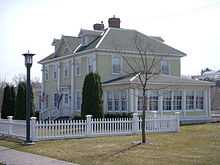Longfellow, Minneapolis
| Longfellow | |
|---|---|
| Community | |
 | |
| Country | United States |
| State | Minnesota |
| County | Hennepin |
| City | Minneapolis |
| Neighborhoods | |
| Area[1] | |
| • Total | 4.962 sq mi (12.85 km2) |
| Population (2010)[2] | |
| • Total | 27,775 |
| • Density | 5,600/sq mi (2,200/km2) |
| Time zone | CST (UTC-6) |
| • Summer (DST) | CDT (UTC-5) |
| ZIP code | 55404, 55406, 55417 |
| Area code(s) | 612 |
| Historical population | |||
|---|---|---|---|
| Census | Pop. | %± | |
| 1980 | 28,675 | ||
| 1990 | 28,618 | −0.2% | |
| 2000 | 27,776 | −2.9% | |
| 2010 | 27,775 | 0.0% | |
Longfellow is a defined community in Minneapolis, Minnesota which includes five smaller neighborhoods inside of it: Cooper, Hiawatha, Howe, Longfellow, and Seward. Grouped with South Minneapolis along the city's eastern border with the Mississippi River, Longfellow takes its name from Longfellow neighborhood which in turn is named after Henry Wadsworth Longfellow. The renowned American poet incorporated elements into his poem The Song of Hiawatha from Henry Schoolcraft's accounts of native Dakota lore in Minnesota which included Minnehaha Falls in Longfellow's southern tip. The early reference of Highway 55 as Hiawatha Avenue, along the west border, may have influenced the naming decision when community borders were drawn in the 1960s. Hiawatha Avenue is the main thoroughfare leading north into Downtown Minneapolis and south to the Minneapolis-Saint Paul Airport.
Longfellow is home to the Danish American Center, Minnehaha Academy, Christ Church and the Longfellow House. The area is typically recognized by bungalow style Craftsman homes built in the 1920s. Minnehaha Falls was once a national attraction and still is an important cultural node of the Twin Cities.[3] The west border was once an agri-industrial and milling processing center served by the Northern Pacific Railway. Today the grain silos and factories along the length of the highway are set to make way for new residential condo and apartment building development.
History
The city did not acquire land south of Franklin Avenue until 1881 and 1883 with the last half of Longfellow annexed in 1887 from Richfield.[4] The area was largely built from 1906 through the 1920s when streetcar and residential rail became accessible. Also the advent of ready-to-assemble homes such as Sears Catalog Homes made homeownership accessible to the primarily immigrant population of the city who could not afford the carpentry or craftsmanship to build single-family homes (or mansions) of the era. Most of these early homeowners were first and second generation Scandinavians who moved out from Cedar Riverside. Even by 1930, the south area was still a major immigrant hub compared to the southwest area with a high foreign-born or second generation population.[5]

Longfellow's popular The Song of Hiawatha spurred national interest in Minnehaha Falls and his name became associated with the area. The poet's name would be further emphasized when the Longfellow House was built in 1906. A local businessman, Robert Fremont "Fish" Jones, commissioned the 2/3 scale replica of Henry Wadsworth Longfellow's original home in Cambridge, Massachusetts. The house was placed as part of the Longfellow Zoological Gardens at 4001 Minnehaha Parkway East, which Jones ran. Jones died in 1934 and the house was deeded to the city. For a short period it was a Minneapolis public library serving the community until it was moved and restored by the Park Board in 1994 to its current location near Minnehaha Falls.[6] It is presently an interpretive and information center for the Minneapolis Park System.[7]
References
- ↑ "Greater Longfellow neighborhood in Minneapolis, Minnesota (MN), 55404, 55406, 55417 detailed profile". City-Data. 2011. Retrieved 2013-11-12.
- ↑ "Minneapolis Community Profile: Longfellow" (PDF). Minnesota Compass. October 2011. Retrieved 2013-11-12.
- ↑ Northern Pacific Railway brochure
- ↑ "A History of Minneapolis: Governance and Infrastructure". Minneapolis Library. 2004.
- ↑ "A History of Minneapolis: 20th Century Growth and Diversity: Maps, 1930s". Minneapolis Library. 2004.
- ↑ "The Longfellow House". Historic Homes of MN. March 14, 2008.
- ↑ Longfellow House at Mpls Park site
External links
| ||||||||||||||||||||||||||||||||||||||